Hybrid-Excited Permanent Magnet-Assisted Synchronous Reluctance Machine
Abstract
:1. Introduction
2. Hybrid-Excited Machines
- Synchronous machines with permanent magnets [1,2]. The hybrid-excited synchronous machine with contactless energy transfer can be a representative of this group of machines (Figure 1a). It has the ability to adjust the excitation flux by using an additional coil on the machine rotor. Supply coils for wireless power transfer relate to the housing of the machine.
- Flux-switching machines [3], represented by the hybrid-excited switched-flux permanent magnet machine (Figure 1b), where the iron flux bridge adjacent to the DC filed winding slots is utilized as well to enhance flux-controllability. It has high torque density, sinusoidal back-EMF, and hence, lower torque ripple. In [4], the influence of stator and rotor pole combinations on machine parameters have been theoretically and experimentally tested. Similar designs have been presented in [5,6]. In these papers, the simulation and experimental research of hybrid-excited flux-switching PM machines with iron flux bridges have been presented.
- Doubly salient machines [7] that look like the hybrid-excited asymmetric stator pole doubly salient machine from Figure 1c, have a unique ratio of the number of stator and rotor poles. The angle between the two stator poles on adjacent segments of π-shaped iron cores α is different from that between the stator poles on the same segment, resulting in a non-uniform distribution of stator poles along the circumference of the stator yoke. A similar design has also been presented in [8].
- Axial flux hybrid-excited machines with core-wound coils [9] (Figure 1d). This machine is integrated with a planetary reducer. The transmission shaft connects the output of the motor to the input of the reducer, resulting in the function to slow down and increase torque. Similar solutions have also been presented in [10,11].
- Dual rotor/stator machines [14]—the representative of which is the dual-stator-switched flux consequent pole permanent magnet machine (Figure 1f), with an unequal number of teeth. This machine has two stators, the outer and inner stator, and a sandwiched rotor. The outer stator has three-phase armature windings and semi-closed slots, and the inner stator has the iron core and field winding for providing excitation and flux regulation. The sandwiched rotor has the consequent pole PMs to improve the torque density. It should be noted that the inner stator has an unequal length of teeth, and the long-length teeth align with the outer stator slots.
- Machines with DC winding on the stator [15]. An example of this group of machines is the Hybrid-Excited Permanent Magnet Machine with additional DC field windings (Figure 1g). This machine has PMs located on the rotor side and DC field windings in the stator side to realize the flux adjustability while ensuring high torque density.
- Claw pole machines [17], such as the hybrid-excited claw pole generator with skewed and non-skewed permanent magnets on the rotor (Figure 1i). The novelty of this machine is the existence of non-skewed permanent magnets on claws of one part of the rotor and skewed permanent magnets on the second one.
- Hybrid-excited Vernier machines are another group of machines. The authors of [18] presented typical structures of these machines with PMs mounted on the surface and using magnetic concentrators (Figure 1j). The authors of [19] presented a Vernier permanent magnet machine with homopolar topology, while the authors of [20] presented research of the machine where rotor consists of two parts: with permanent magnets and the wound electromagnets.
- Consequent-pole permanent magnet machines [21]—a machine having a structure similar to a consequent pole permanent magnet motor (Figure 1k), where the magnetic circuit of the rotor iron core is necessarily imbalanced, but the impedance of the stator windings can be balanced if the two windings (on the real PM pole sides) and the other two windings (on the image pole sides) are connected in series.
3. Machine Design and Mathematical Model
- p—number of pole pairs;
- Ψd, Ψq—d- and q-axis magnetic fluxes;
- Ψpm—flux generated by PMs;
- Id, Iq—d- and q-axis stator currents;
- Ld, Lq—d- and q-axis inductances;
- MDC—mutual inductance of the additional coil;
- IDC—current in the additional coil.
- Torque produced by means of a flux from permanent magnets (TPM);
- Torque generated by the flux coming from the additional excitation coil (Texc);
- Reluctance torque resulting from the difference in inductances in d- and q-axes of the machine (Trel).
4. Simulation Results
5. Results of Experimental Tests and Comparison with FEM Results
- –
- Network parameter analyzer NORMA 5000 (1);
- –
- Three current coils (2);
- –
- Two oscilloscopes Tektronix (3);
- –
- Laboratory power supply (4);
- –
- Computer station (5);
- –
- Servo control system Bernecker&Reiner with a control panel (6);
- –
- Drive unit Bernecker&Reiner (7);
- –
- Torque meter Dataflex 32 (8);
- –
- Slip rings (9);
- –
- HEPMa-SynRM prototype (10).
6. Conclusions
Author Contributions
Funding
Institutional Review Board Statement
Acknowledgments
Conflicts of Interest
References
- Wardach, M.; Bonislawski, M.; Palka, R.; Paplicki, P.; Prajzendanc, P. Hybrid Excited Synchronous Machine with Wireless Supply Control System. Energies 2019, 12, 3153. [Google Scholar] [CrossRef] [Green Version]
- Amara, Y.; Vido, L.; Gabsi, M.; Hoang, E.; Ben Ahmed, A.H.; Lecrivain, M. Hybrid Excitation Synchronous Machines: Energy-Efficient Solution for Vehicles Propulsion. IEEE Trans. Veh. Technol. 2008, 58, 2137–2149. [Google Scholar] [CrossRef]
- Sun, X.; Zhu, Z.Q. Investigation of DC Winding Induced Voltage in Hybrid-Excited Switched-Flux Permanent Magnet Machine. IEEE Trans. Ind. Appl. 2020, 56, 3594–3603. [Google Scholar] [CrossRef]
- Zhu, Z.Q.; Afinowi, I.A.A.; Guan, Y.; Mipo, J.C.; Farah, P. Hybrid-Excited Stator Slot Permanent Magnet Machines—Influence of Stator and Rotor Pole Combinations. IEEE Trans. Magn. 2015, 52, 1–10. [Google Scholar] [CrossRef]
- Owen, R.L.; Zhu, Z.Q.; Jewell, G.W. Hybrid-Excited Flux-Switching Permanent-Magnet Machines with Iron Flux Bridges. IEEE Trans. Magn. 2010, 46, 1726–1729. [Google Scholar] [CrossRef]
- Dupas, A.; Hoang, E.; Hlioui, S.; Gaussens, B.; Lecrivain, M.; Gabsi, M. Performances of a hybrid excited flux-switching DC-alternator: Analysis and experiments. In Proceedings of the 2014 International Conference on Electrical Machines (ICEM), Berlin, Germany, 2–5 September 2014; pp. 2644–2649. [Google Scholar] [CrossRef] [Green Version]
- He, M.; Xu, W.; Zhu, J.; Ning, L.; Du, G.; Ye, C. A Novel Hybrid Excited Doubly Salient Machine With Asymmetric Stator Poles. IEEE Trans. Ind. Appl. 2019, 55, 4723–4732. [Google Scholar] [CrossRef]
- Shakal, A.; Liao, Y.; Lipo, T.A. A permanent magnet ac machine structure with true field weakening capability. Electr. Mach. Power Syst. 1996, 24, 497–509. [Google Scholar] [CrossRef]
- Geng, W.; Zhang, Z.; Li, Q. Concept and Electromagnetic Design of a New Axial Flux Hybrid Excitation Motor for In-wheel Motor Driven Electric Vehicle. In Proceedings of the 2019 22nd International Conference on Electrical Machines and Systems (ICEMS), Harbin, China, 11–14 August 2019; pp. 1–6. [Google Scholar]
- Luo, J. Axial Flux Circumferential Current Permanent Magnet Electric Machine. Ph.D. Thesis, University of Wisconsin-Madison, Madison, WI, USA, 1999. [Google Scholar]
- Zepp, L.P.; Medlin, J.W. Brushless Permanent Magnet Motor or Alternator with Variable Axial Rotor/Stator Alignment to Increase Speed Capability. U.S. Patent 6555941 B1, 29 April 2003. [Google Scholar]
- Hoang, T.-K.; Vido, L.; Gillon, F.; Gabsi, M. Structural optimization to maximize the flux control range of a double excitation synchronous machine. Math. Comput. Simul. 2018, 158, 235–247. [Google Scholar] [CrossRef]
- Aydin, M.; Huang, S.; Lipo, T.A. A new axial flux surface mounted permanent magnet machine capable of field control. In Proceedings of the Conference Record of the 2002 IEEE Industry Applications Conference, 37th IAS Annual Meeting (Cat. No. 02CH37344), Pittsburgh, PA, USA, 13–18 October 2002; pp. 1250–1257. [Google Scholar]
- Wei, L.; Nakamura, T. Optimization Design of a Dual-Stator Switched Flux Consequent Pole Permanent Magnet Machine With Unequal Length Teeth. IEEE Trans. Magn. 2020, 56, 1–5. [Google Scholar] [CrossRef]
- Liwen, L.; Hongmei, L.; Zhiwei, C.; Tian, Y.; Rundong, L.; Jingkui, M. Design of a Hybrid Excited Permanent Magnet Machine with AC Field Winding Excitation. In Proceedings of the 22nd International Conference on Electrical Machines and Systems (ICEMS), Harbin, China, 11–14 August 2019. [Google Scholar] [CrossRef]
- Diab, H.; Amara, Y.; Barakat, G. Open Circuit Performance of Axial Air Gap Flux Switching Permanent Magnet Synchronous Machine for Wind Energy Conversion: Modeling and Experimental Study. Energies 2020, 13, 912. [Google Scholar] [CrossRef] [Green Version]
- Wardach, M. Hybrid excited claw pole generator with skewed and non-skewed permanent magnets. Open Phys. 2017, 15, 902–906. [Google Scholar] [CrossRef] [Green Version]
- Xu, L.; Liu, G.; Zhao, W.; Ji, J. Hybrid excited vernier machines with all excitation sources on the stator for electric vehicles. Prog. Electromagn. Res. M 2016, 46, 113–123. [Google Scholar] [CrossRef] [Green Version]
- Noguchi, T.; Murakami, K.; Hattor, A.; Kaneko, Y. Proposal and operation characteristics of novel consequentpole permanent magnet motor. J. Phys. Conf. Ser. 2019, 1367, 012032. [Google Scholar] [CrossRef]
- Marcic, T. A short review of energy-efficient line-start motor design. Prz. Elektrotech. 2011, 87, 119–122. [Google Scholar]
- Li, W.; Ching, T.W.; Chau, K.T. A Hybrid-Excited Vernier Permanent Magnet Machine Using Homopolar Topology. IEEE Trans. Magn. 2017, 53, 1–7. [Google Scholar] [CrossRef]
- Bernatt, J.; Gawron, S.A.; Glinka, M. Experimental Validation of Hybrid Excited Permanent Magnet Synchronous Generator. Prz. Elektrotech. 2012, 88, 66–70. [Google Scholar]
- Ganesan, A.U.; Chokkalingam, L.N. Self-start synchronous reluctance motor new rotor designs and its performance characteristics. Int. Trans. Electr. Energy Syst. 2019, 29, 22. [Google Scholar] [CrossRef]
- Zhu, Z.Q.; Cai, S. Overview of Hybrid Excited Machines for Electric Vehicles. In Proceedings of the 2019 Fourteenth International Conference on Ecological Vehicles and Renewable Energies (EVER), Monte-Carlo, Monaco, 8–10 May 2019; pp. 1–14. [Google Scholar] [CrossRef]
- Wardach, M.; Palka, R.; Paplicki, P.; Prajzendanc, P.; Zarebski, T. Modern Hybrid Excited Electric Machines. Energies 2020, 13, 5910. [Google Scholar] [CrossRef]
- Asfirane, S.; Hlioui, S.; Amara, Y.; Gabsi, M. Study of a Hybrid Excitation Synchronous Machine: Modeling and Experimental Validation. Math. Comput. Appl. 2019, 24, 34. [Google Scholar] [CrossRef] [Green Version]
- Wardach, M.; Grochocki, P.; Paplicki, P.; Piatkowska, H. Novel Concept of PM Electric Machine with Magnetic Barriers and Excitation Coils in the Rotor. In Proceedings of the 14th Conference on Selected Issues of Electrical Engineering and Electronics WZEE’2018, Szczecin, Poland, 19–21 November 2018. [Google Scholar] [CrossRef]
- May, H.; Palka, R.; Paplicki, P.; Szkolny, S.; Wardach, M. Comparative research of different structures of a perma-nent-magnet excited synchronous machine for electric vehicles. Prz. Elektrotech. 2012, 88, 53–55. [Google Scholar]
- Wardach, M.; Paplicki, P.; Palka, R.; Cierzniewski, P. Influence of the rotor construction on parameters of the electrical ma-chine with permanent magnets. Prz. Elektrotech. 2011, 87, 131–134. [Google Scholar]
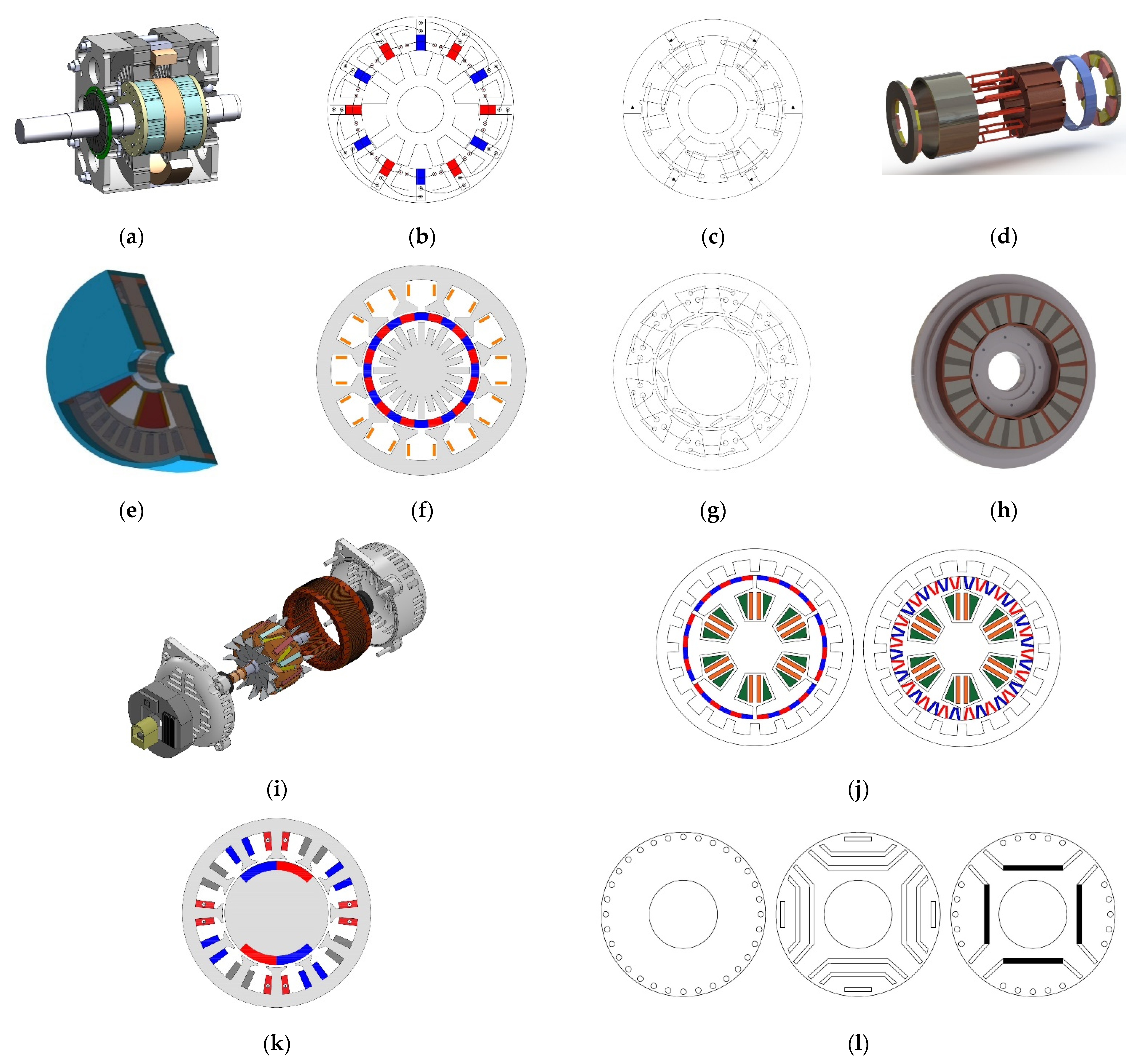

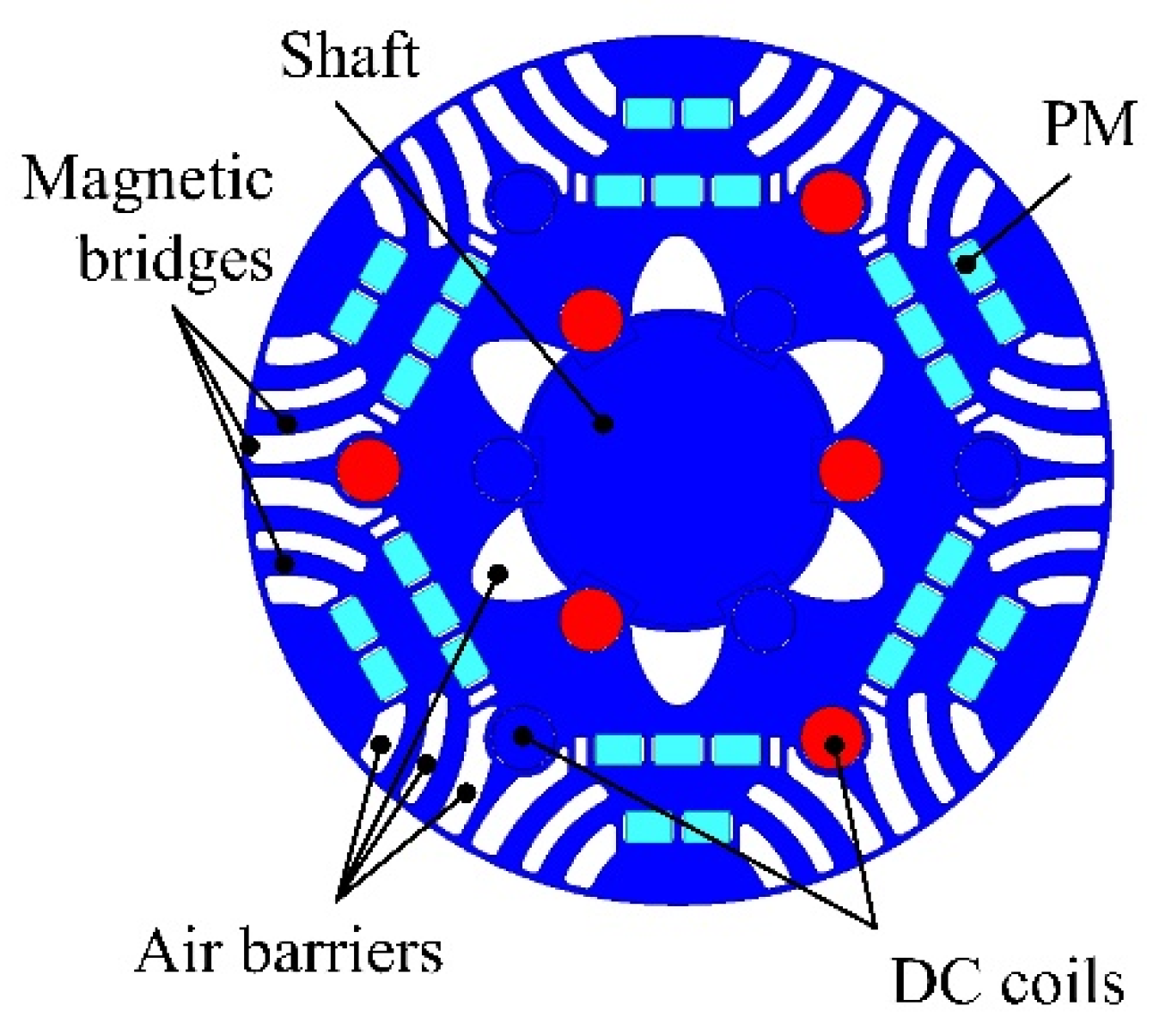


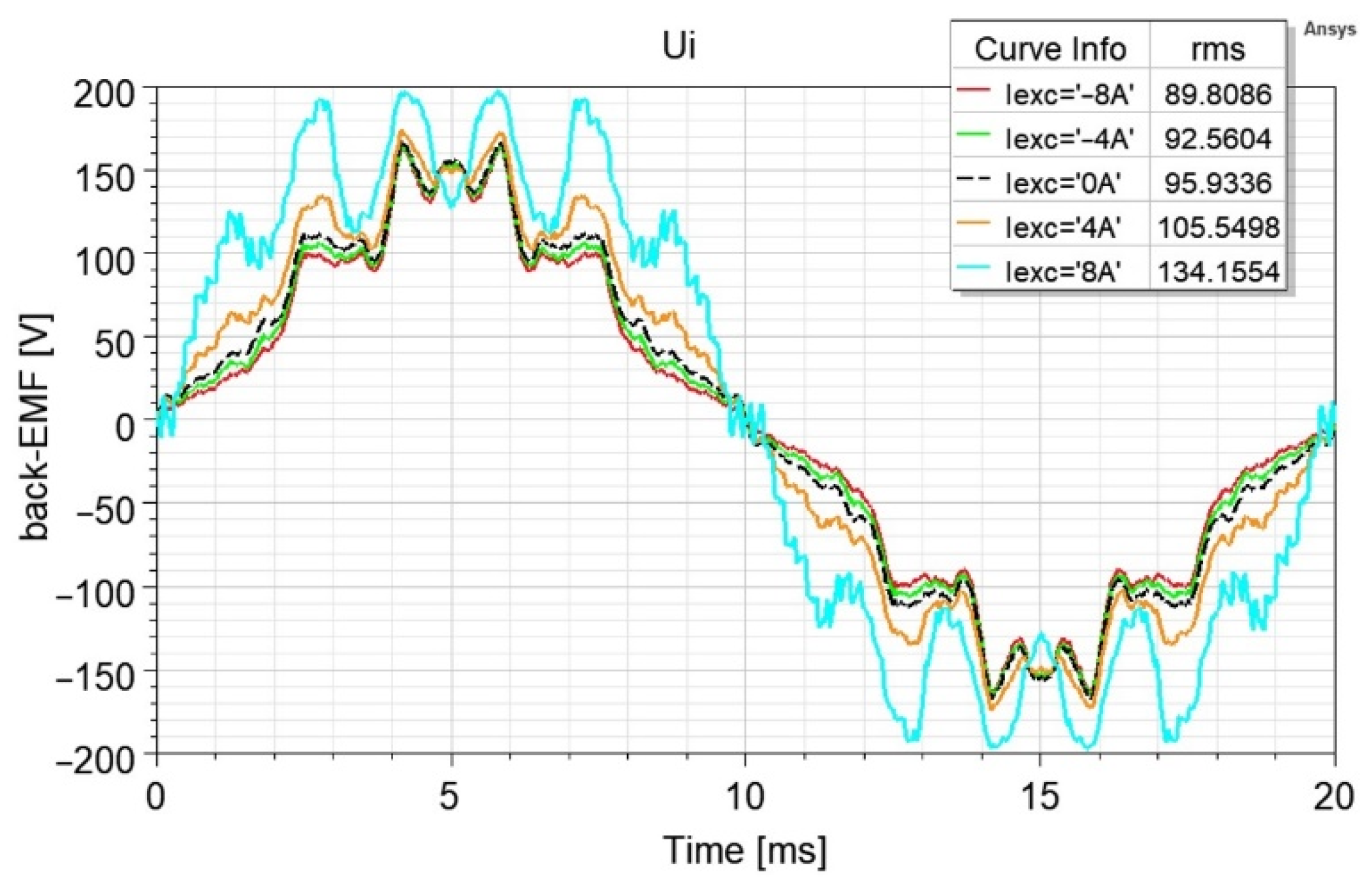
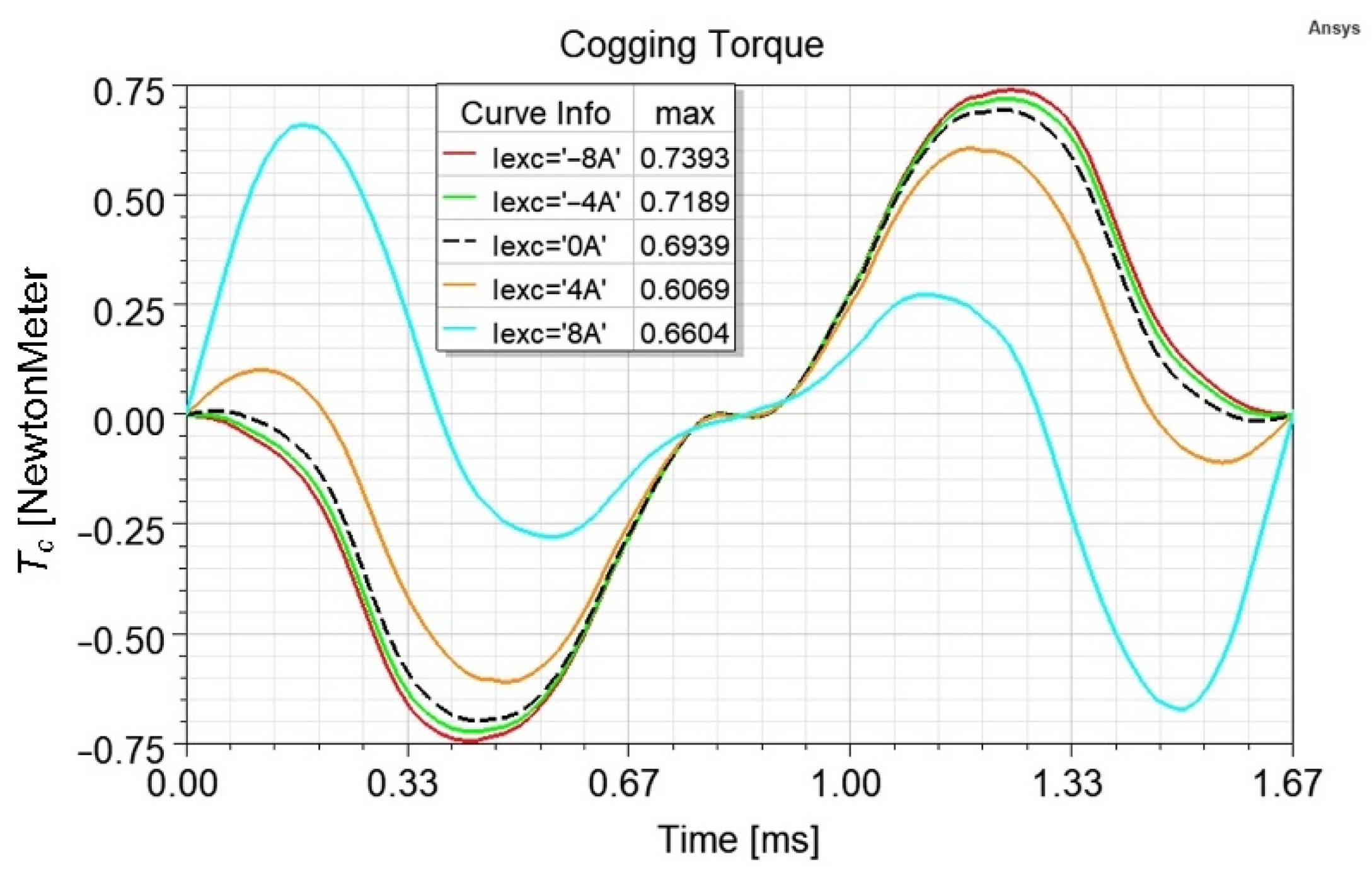
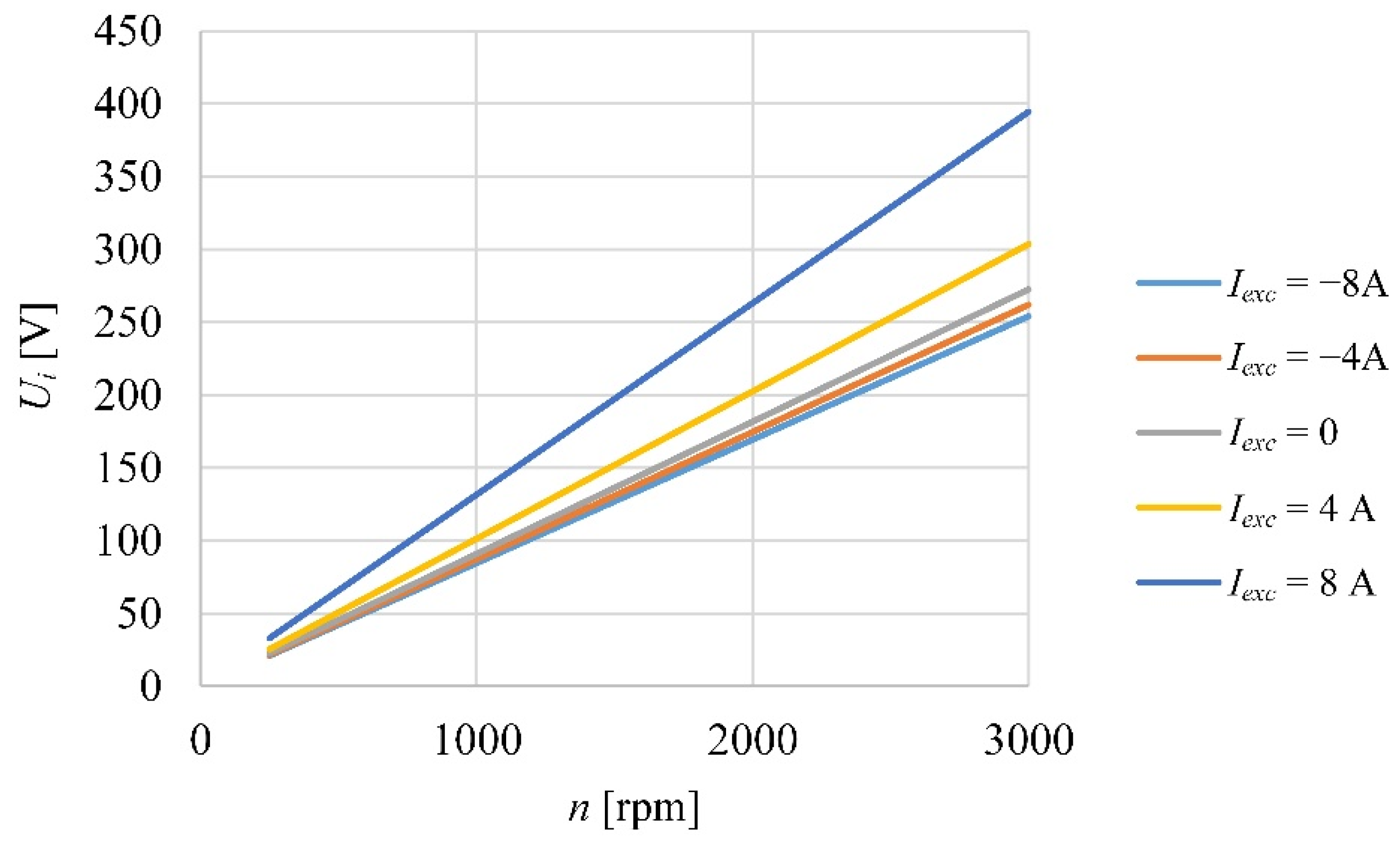
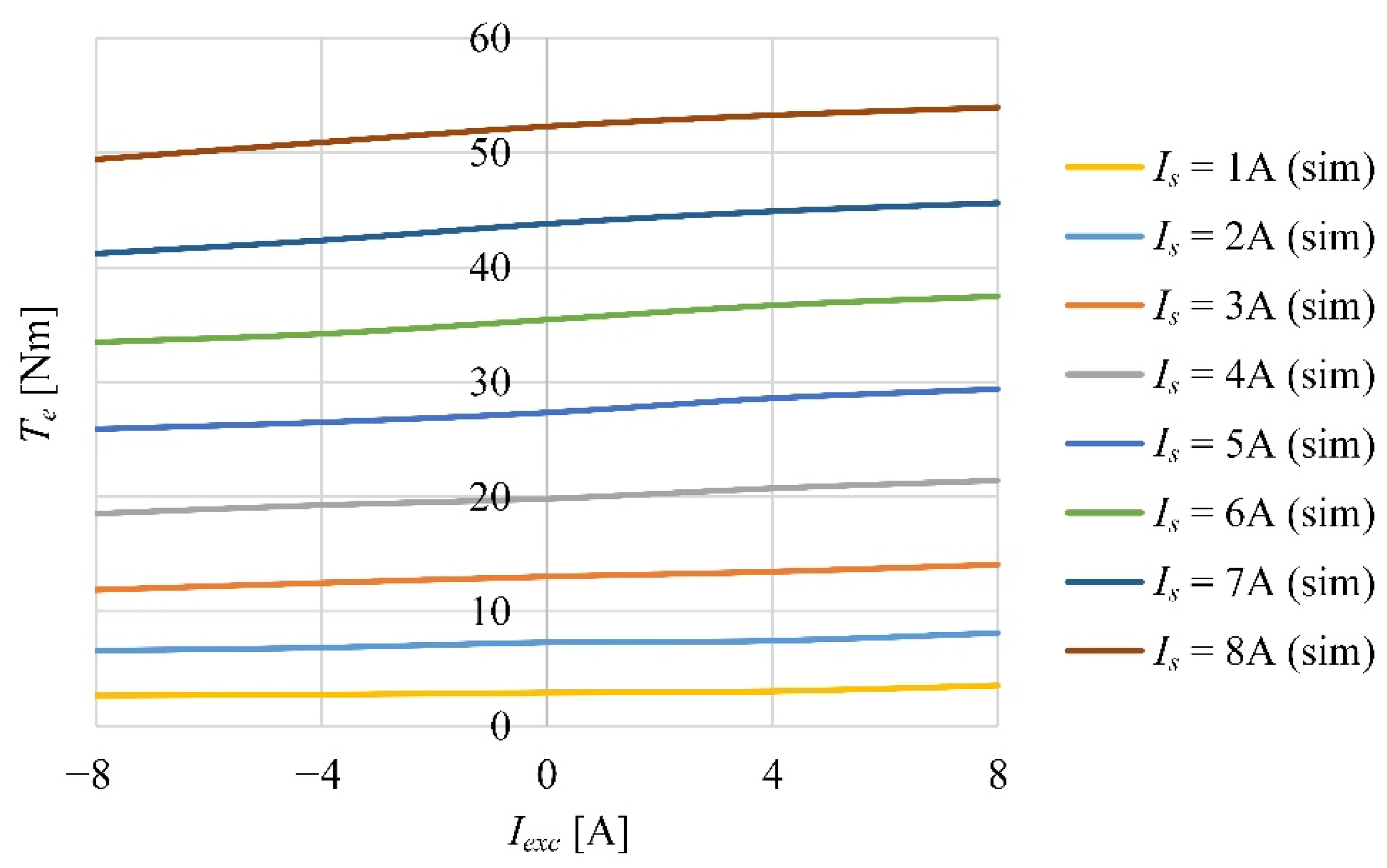




| No. | Design | Advantages | Disadvantages |
|---|---|---|---|
| 1. | Hybrid-excited synchronous machine | very good back-EMF value regulation | complicated design, large mass, the need to perform 3D simulations |
| 2. | Hybrid-excited switched-flux permanent magnet machine | simply design | average use of weight (volume) in relation to power |
| 3. | Doubly salient machine | simply design | average use of weight (volume) in relation to power |
| 4. | Axial flux hybrid excitation motor | high torque | complicated design, the need to perform 3D simulations |
| 5. | Axial-radial flux machine | use of axial and radial fluxes | complicated design, the need to perform 3D simulations |
| 6. | Dual rotor/stator machine | simply design | average use of weight (volume) in relation to power |
| 7. | Hybrid-Excited Machines with DC winding on stator | simply design | average use of weight (volume) in relation to power |
| 8. | Stator of double stator inner rotor axial air gap flux switching permanent magnet machine | high torque | complicated design, the need to perform 3D simulations |
| 9. | Hybrid-excited claw pole generator | simply design | the need to perform 3D simulations |
| 10. | Hybrid-excited Vernier machine | simply design | average use of weight (volume) in relation to power |
| 11. | Consequent-pole permanent magnet machines | simply design | average use of weight (volume) in relation to power excitation flux cannot be adjusted |
| 12. | Line-start interior permanent magnet synchronous motor | simply design line-start machine | excitation flux cannot be adjusted |
| No. | Parameter | Description | Value |
|---|---|---|---|
| 1. | Pn | Nominal power | 6.5 kW |
| 2. | In | Nominal current rms | 8.4 A |
| 3. | Un | Nominal voltage rms | 400 V |
| 4. | Y | Phase connection | star |
| 5. | Rso | Stator’s outer radius | 110 mm |
| 6. | Rsi | Stator’s inner radius | 68.0 mm |
| 7. | Rro | Rotor’s outer radius | 67.5 mm |
| 8. | ag | Air gap length | 0.5 mm |
| 9. | l | Machine’s length | 199 mm |
| 10. | p | Number of pole pairs | 3 |
| 11. | ks | Number of stator windings | 35 |
| 12. | kIexc | Number of rotor DC windings’ wires | 29 |
| 13. | s | Number of slots | 36 |
| 14. | lPM25 lPM30 | Length of PMs 1st type Length of PMs 2nd type | 25 mm 30 mm |
| 15. | hPM | Height of PMs | 2.4 mm |
| 16. | wPM | Width of PMs | 7 mm |
| 17. | kPM25 kPM30 | Number of PMs lPM25 = 25 mm Number of PMs lPM30 = 30 mm | 245 185 |
| 18. | Steel sheet type—silicon steel | M400-50A | |
| 19. | Hs2 | Slot body height | 14.8 mm |
| 20. | Bs0 | Slot opening width | 3 mm |
| 21. | Bs1 | Slot wedge maximum width | 5.4 mm |
| 22. | Bs2 | Slot body bottom width | 8 mm |
Publisher’s Note: MDPI stays neutral with regard to jurisdictional claims in published maps and institutional affiliations. |
© 2022 by the authors. Licensee MDPI, Basel, Switzerland. This article is an open access article distributed under the terms and conditions of the Creative Commons Attribution (CC BY) license (https://creativecommons.org/licenses/by/4.0/).
Share and Cite
Wardach, M.; Prajzendanc, P.; Palka, R.; Cierzniewski, K.; Pstrokonski, R.; Cichowicz, M.; Pacholski, S.; Ciurus, J.; Hao, C. Hybrid-Excited Permanent Magnet-Assisted Synchronous Reluctance Machine. Energies 2022, 15, 2997. https://doi.org/10.3390/en15092997
Wardach M, Prajzendanc P, Palka R, Cierzniewski K, Pstrokonski R, Cichowicz M, Pacholski S, Ciurus J, Hao C. Hybrid-Excited Permanent Magnet-Assisted Synchronous Reluctance Machine. Energies. 2022; 15(9):2997. https://doi.org/10.3390/en15092997
Chicago/Turabian StyleWardach, Marcin, Pawel Prajzendanc, Ryszard Palka, Kamil Cierzniewski, Rafal Pstrokonski, Michal Cichowicz, Szymon Pacholski, Jakub Ciurus, and Chen Hao. 2022. "Hybrid-Excited Permanent Magnet-Assisted Synchronous Reluctance Machine" Energies 15, no. 9: 2997. https://doi.org/10.3390/en15092997
APA StyleWardach, M., Prajzendanc, P., Palka, R., Cierzniewski, K., Pstrokonski, R., Cichowicz, M., Pacholski, S., Ciurus, J., & Hao, C. (2022). Hybrid-Excited Permanent Magnet-Assisted Synchronous Reluctance Machine. Energies, 15(9), 2997. https://doi.org/10.3390/en15092997










